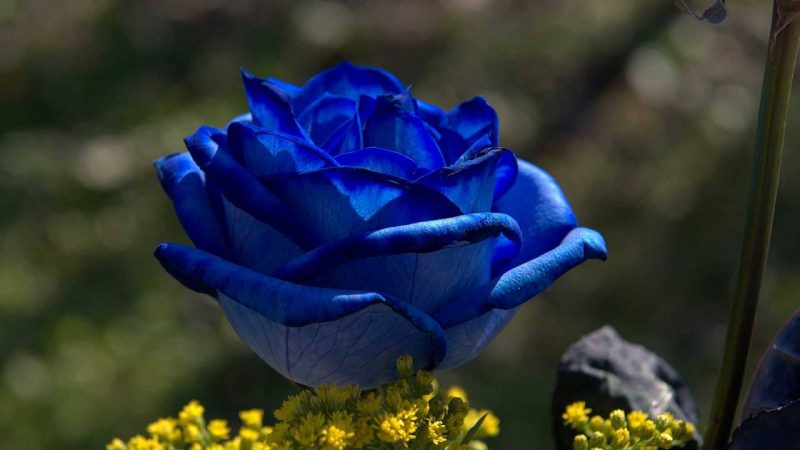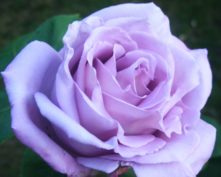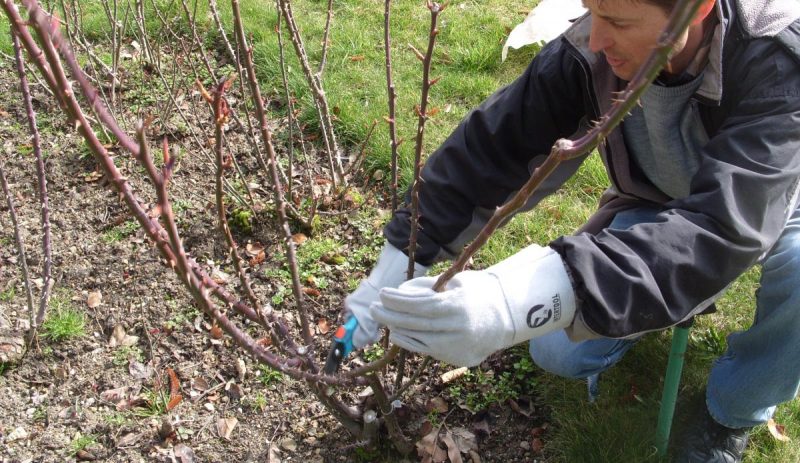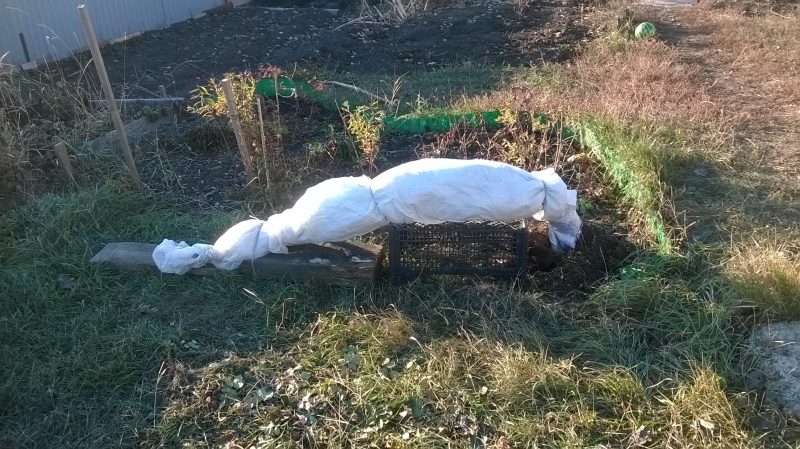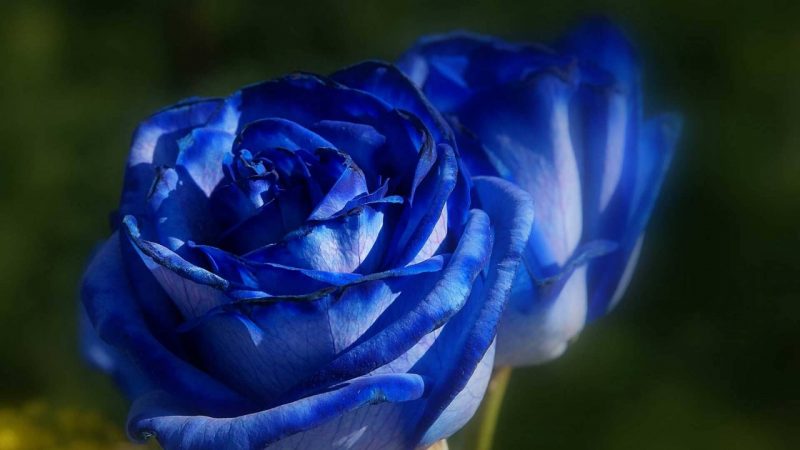A great way to impress and delight a loved one is to give him an unusual flower. For example, a blue rose. An outlandish plant grown by oneself will tell the addressee much more than a bouquet bought. But is it really possible to grow such a rarity in your own garden?
Material Content:
Blue roses - do they exist?
The existence of blue roses has always been shrouded in mystery. There are many types of seedlings and seeds of plants on sale that have the word “blue” or “blue” in their names, but in reality the buds of such flowers turn out to be lilac or lilac. In flower shops, bouquets of roses of a deep blue color are sold. So is it possible to grow these incredible flowers?
In fact, “strangeness” is easily explained.
There are no blue or blue roses in nature, since this plant simply does not have the gene responsible for the blue pigment.
Breeders all over the world, to find out such a feature of the “Queen of Flowers”, were not at a loss and began to transplant forget-me-not genes into white, burgundy and pink varieties.
The Japanese, on the other hand, came up with the idea to introduce the pansy gene to the rose. The best minds worked on the task for about 20 years, and the result of painstaking work was the Applause variety, bred in 2009. Of all the existing hybrids, roses of this species were the most blue, but they did not receive distribution due to increased allergenicity and other difficulties encountered.
The maximum achievement of breeders, accessible to everyone who wants to grow a culture of an unusual shade, is climbing roses of lilac and lilac flowers, which, when properly grown and at certain times of the day, briefly change their color to blue.
But what about roses in flower shops? Where did the beautiful, bright blue-blue color come from? It's simple - these shades are obtained by coloring the buds with food colors through food cut flowers or banal spray paint on the petals from the spray can. All this can easily be done at home, instead of overpaying someone for cheating.
And yet, looking ahead, it is worth noting that it is still possible to grow unrealistic blue roses in the garden. For this, gardeners came up with a little trick.
The best blue varieties of climbing roses
Varieties bred by breeders, although they do not have a bright blue color, are also worthy of close attention. Indisputable leaders among them: Indigoletta and Blue Moon (a brief description of the flower of each species is given below). Both of them are climbing varieties, that is, they have long branched shoots that can twist around any base. As the latter, arches, pillars, arbors and other decorative structures are often used.
- “Indigoletta” (also called Blue Lady or Blue Queen) is an original rose with large velvety buds of a delicate lilac color with a distinct blue tint. Bred in 1981 in a place called Lottum, which is located in the province of Limburg (Netherlands). The small village has its own rosary nursery and shop, as well as rose festivals and exhibitions of new varieties. The length of the lashes of this species can reach 4 meters in height, and the diameter of the flowers varies from 8 to 12 centimeters. Indigoletta is a very grateful flower. It is resistant to disease and frost, and with proper care can bloom twice a year.
- Blue Moon is a climbing chameleon rose. Her flowers do not have a certain color. They can be gently lilac with a silver tint in partial shade, saturated blue when exposed to direct sunlight, or even pink in the evening and in the shade. The length of the lashes can reach 3 meters, and the diameter of the flower is 10 centimeters. The bud has up to 30 double petals. This variety has a lot of advantages, among which, in addition to incredible beauty, frost resistance (can withstand temperature drops of –35 degrees), good disease resistance, quick rooting and double flowering per season.
A promising description ... But how to grow these varieties in the harsh climatic conditions of Russia with huge temperature drops throughout the year? Is quite real! Perseverance, diligence and patience will be required, but the result will more than meet all expectations.
Features and landing rules
Both varieties present similar requirements for planting and care, so the further instructions do not contain a specification by name, but only general recommendations.
Blue-colored climbing roses are planted near arches or arbors. The location on the site has a direct impact on the quality of branching and the number of buds.
It is important to choose sunny places, penumbra will do. Constantly in absolute shadow, the flower will perish.
The soil should be loose, moderately moist and saturated with oxygen, which is achieved by adding drainage. Strong gusts of wind can break the shoots of the plant, which also needs to be considered when choosing the ideal location.
Planting a blue rose is as follows:
- It is necessary to prepare a pit with a diameter of about a meter, and a depth of half a meter.
- At the bottom, pour a 10-centimeter layer of drainage (sand, expanded clay, brick chips and pebbles of small sizes).
- Set the seedling in the center and spread its roots.
- Fill the roots with the nutrient mixture so that the root neck is at a depth of no more than 3-5 centimeters from the surface of the earth.
The composition of the nutrient mixture:
- soil and sand - 2 parts out of 8;
- humus - 3 parts of 8;
- peat - 1 part of 8.
There, it is desirable to add 0.2 kg of ash and a bag (200 gm) of nutritious fertilizer for climbing roses.
On top of the mixture, you can sprinkle a thin layer of ordinary soil (for better tamping), compact the soil around the roots and tilt the seedling to the side of the support, located 20 cm from the future bush.
Watering, pruning and top dressing
All varieties of blue beauty are very grateful. They delight gardeners with long and lush flowering, but without proper care the plant simply withers. It needs to be loosened, watered, fed and trimmed on time.
- This flower does not tolerate scorching sunlight, therefore, in strong heat, the plant should be shaded.
- The first watering after planting should be plentiful. Further, in the absence of rainfall, the plant is watered daily, but in moderation or as necessary, if the earth is wet.
- After each artificial or natural moistening of the soil, it must be loosened. This is done to saturate the earth with oxygen and eliminate stagnation in it of excess moisture. It is recommended to cover the soil around the plant with straw to protect it from drying out.
- Pruning of bushes is carried out in early spring, all blackened and dead branches are removed. In parallel, it is necessary to inspect the plant for damage and pests.
- After pruning, the rose needs to be fed. For this, ready-made nutrient fertilizers are used or mullein is bred in a ratio of 1 to 10 with water.
- To extend the timing and quality of flowering, wilted buds should be cut off.
Winter care
Despite the fact that the climbing varieties of blue roses are frost-resistant, you still need to cook them for the winter. To do this, remove all faded buds, diseased and weak shoots. The bush is covered only after lowering the air temperature to –5 ºС.
Do it like this:
- It is necessary to prepare small indentations in the ground, and in them to build a "bed" of dry grass and leaves, on which the shoots of the plant will be laid.
- Carefully remove all the lashes from the support, roll up, tie and lay on the “bed”.
- Place a film or covering material on top, the edges of which should be fixed with earth embankments, leaving a small hole for air access.
Some gardeners do not lay the whips on the ground, but wrap them in burlap and fasten them back to the base. The roots are hidden under an additional earthen layer.
Reproduction of climbing roses
A climbing blue rose can be propagated by both cuttings and layering.
Reproduction by layering is carried out as follows:
- It is required to bend a healthy and strong whip to the ground and sprinkle with a sufficient layer of soil, leaving 20 shoots on the surface of all centimeters.
- It is necessary to water the layering as a separate bush throughout the summer.
- For winter, shelter an allotted escape.
- In spring, the layering should be cut off and transplanted to a permanent place.
To obtain cuttings, it is necessary to cut off a strong shoot from the middle part of the bush and divide it into 3-4 parts. Each individual stalk is planted in the ground with drainage and sand as a full bush.
Pest and Disease Control
Blue roses have good disease resistance, but weakened bushes still sometimes suffer from powdery mildew, rust, black spotting and gray rot. A good method of dealing with them is a preventive spring spraying of the bush with a Bordeaux mixture (blue vitriol and lime) or Epin. If, however, the flower is sick, then it should be treated with special preparations with fungicides.
Roses are attacked not only by diseases, but also by pests such as thrips, scabies and spider mites, green and rosacea aphids, caterpillars, leaf-cutting bees and others.
For prevention, the bushes are sprayed with chemicals (it is better to purchase universal remedies) several times a year:
- When peeling the first leaves.
- During the emergence of bud buds.
- In the second half of July.
All manipulations with chemicals are allowed only in dry and calm weather.
Gardener tips
And now about those tricks that gardeners came up with for growing a bright blue rose on a full-grown bush.
The secret is simple - it's all about proper watering.
It is required to plant a rose of white or pale pink. Wait until the buds begin to set and start adding food coloring, copper sulfate or potassium permanganate to each watering. The solution must be made weak, otherwise it can harm the plant. Continue this procedure until the end of flowering.
Thus, even an amateur gardener can grow a real bush of a beautiful blue-blue rose on his plot, and breeders around the world seem to need to be a little easier.


